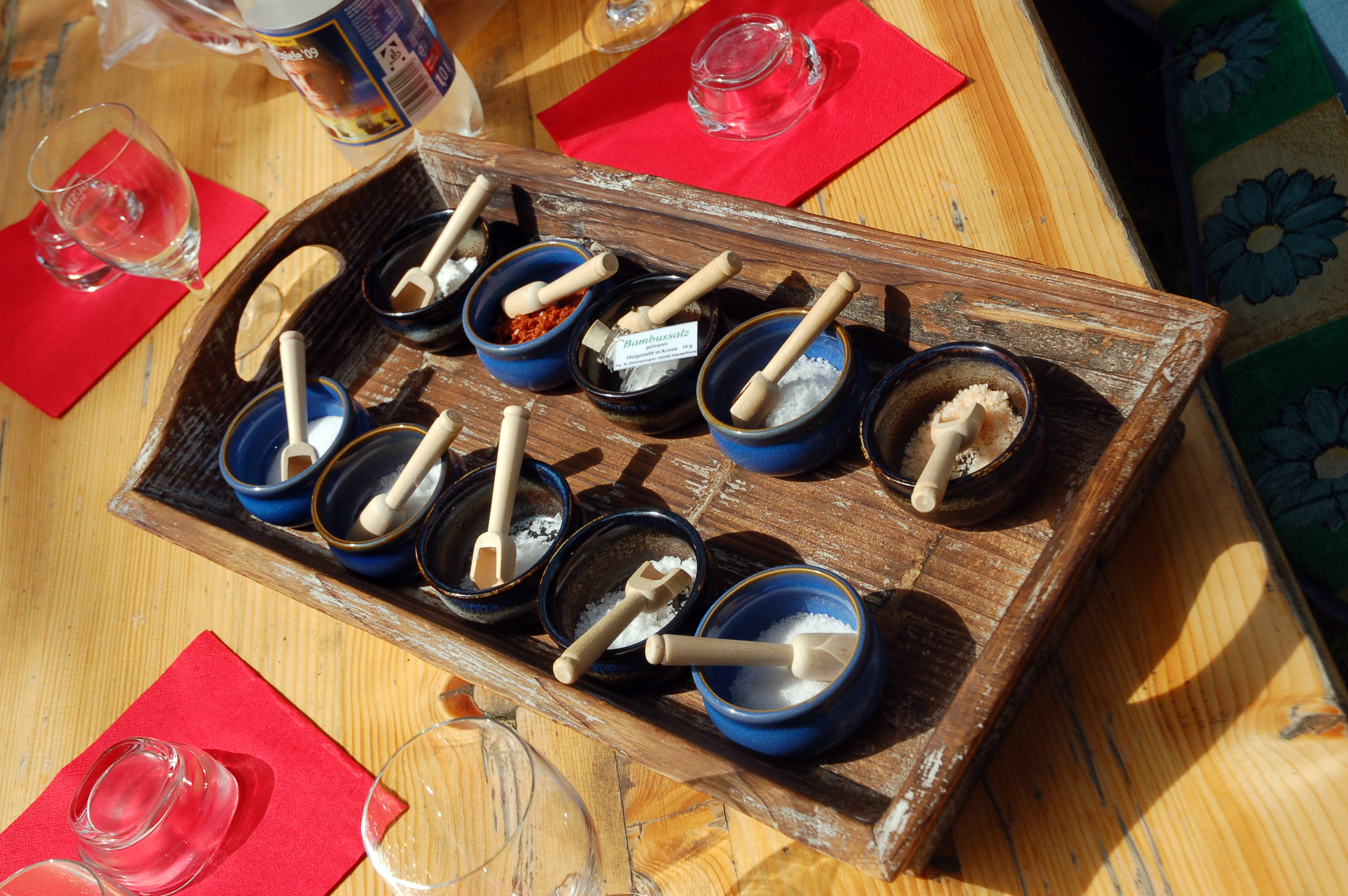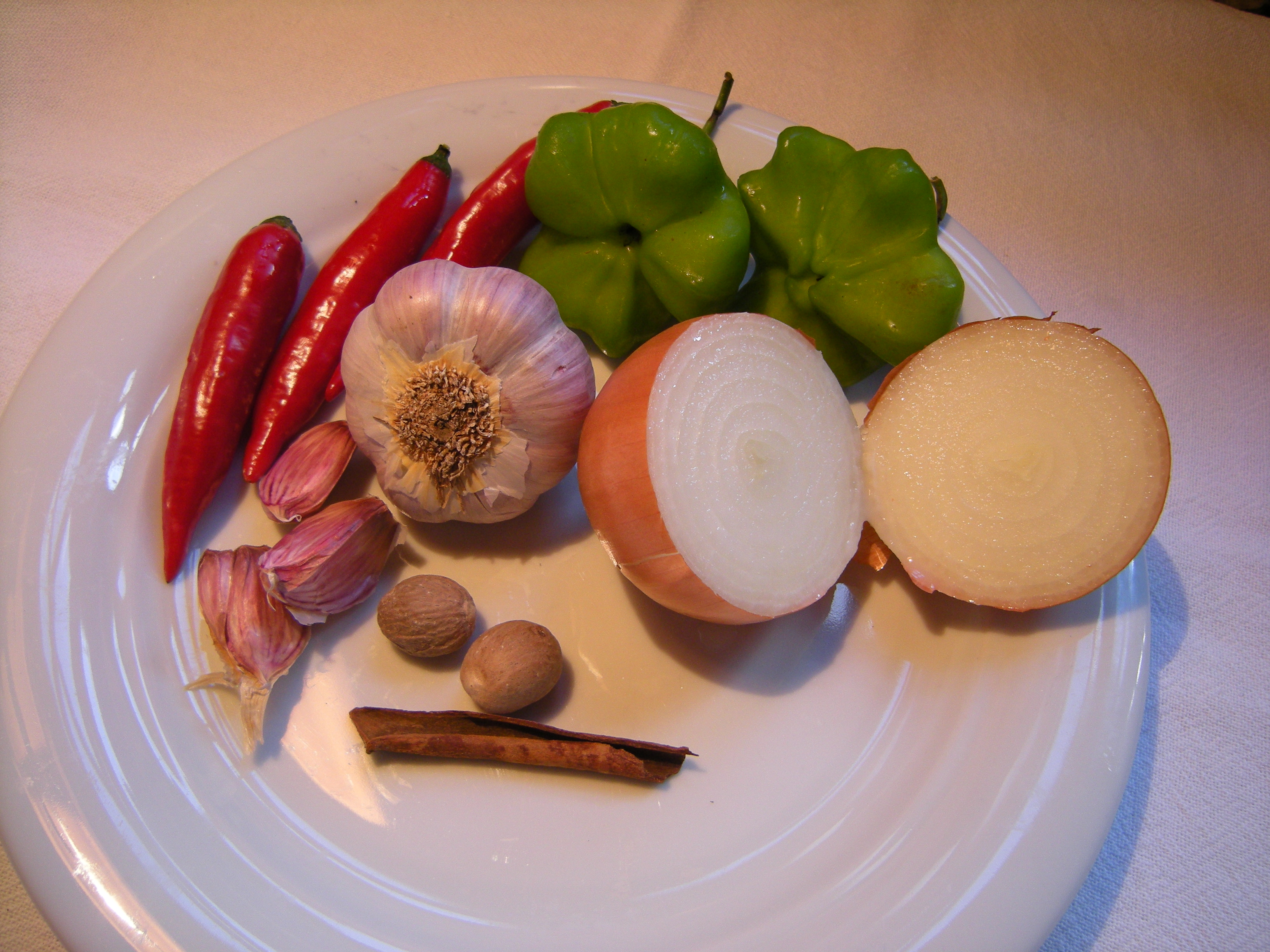Seasonings on:
[Wikipedia]
[Google]
[Amazon]
 Seasoning is the process of supplementing food via
Seasoning is the process of supplementing food via
 # '' Saline seasonings'' –
# '' Saline seasonings'' –
 # ''The pungents'' –
# ''The pungents'' –
 Seasoning is the process of supplementing food via
Seasoning is the process of supplementing food via herb
Herbs are a widely distributed and widespread group of plants, excluding vegetables, with savory or aromatic properties that are used for flavoring and garnishing food, for medicinal purposes, or for fragrances. Culinary use typically distingu ...
s, spice
In the culinary arts, a spice is any seed, fruit, root, Bark (botany), bark, or other plant substance in a form primarily used for flavoring or coloring food. Spices are distinguished from herbs, which are the leaves, flowers, or stems of pl ...
s, and/or salts, intended to enhance a particular flavour.
General meaning
Seasonings include herbs and spices, which are themselves frequently referred to as "seasonings". Salt may be used to draw outwater
Water is an inorganic compound with the chemical formula . It is a transparent, tasteless, odorless, and Color of water, nearly colorless chemical substance. It is the main constituent of Earth's hydrosphere and the fluids of all known liv ...
, or to magnify a natural flavor of a food making it richer or more delicate, depending on the dish. This type of procedure is akin to curing. For instance, sea salt (a coarser-grained salt) is rubbed into chicken
The chicken (''Gallus gallus domesticus'') is a domesticated subspecies of the red junglefowl (''Gallus gallus''), originally native to Southeast Asia. It was first domesticated around 8,000 years ago and is now one of the most common and w ...
, lamb, and beef
Beef is the culinary name for meat from cattle (''Bos taurus''). Beef can be prepared in various ways; Cut of beef, cuts are often used for steak, which can be cooked to varying degrees of doneness, while trimmings are often Ground beef, grou ...
to tenderize the meat and improve flavour. Other seasonings like black pepper
Black pepper (''Piper nigrum'') is a flowering vine in the family Piperaceae, cultivated for its fruit (the peppercorn), which is usually dried and used as a spice and seasoning. The fruit is a drupe (stonefruit) which is about in diameter ...
and basil transfer some of their flavors to the food. A well-designed dish may combine seasonings that complement each other.
In addition to the choice of herbs and seasoning, the timing of when flavors are added will affect the food that is being cooked or otherwise prepared. Seasonings are usually added near the end of the cooking period, or even at the table, when the food is served. The most common table-seasonings are salt, pepper, and acids (such as lemon juice). When seasonings are used properly, they cannot be tasted; their job is to heighten the flavors of the original ingredients.
Researchers have found traces of garlic mustard seeds in prehistoric pots that also contained traces of meat, making this the earliest recording of seasoning food.
Oil infusion
Infused oils are also used for seasoning. There are two methods for doing an infusion—hot and cold.Olive oil
Olive oil is a vegetable oil obtained by pressing whole olives (the fruit of ''Olea europaea'', a traditional Tree fruit, tree crop of the Mediterranean Basin) and extracting the oil.
It is commonly used in cooking for frying foods, as a cond ...
makes a good infusion base for some herbs, but tends to go rancid more quickly than other oils. Infused oils should be kept refrigerated.
Escoffier
In '' Le Guide Culinaire'', Auguste Escoffier (1903), '' Le Guide culinaire'', Editions Flammarion Auguste Escoffier divides seasoning and condiments into the following groups:Seasonings
 # '' Saline seasonings'' –
# '' Saline seasonings'' – salt
In common usage, salt is a mineral composed primarily of sodium chloride (NaCl). When used in food, especially in granulated form, it is more formally called table salt. In the form of a natural crystalline mineral, salt is also known as r ...
, spiced salt, saltpeter.
# ''Acid seasonings'' – plain vinegar (sodium acetate), or same aromatized with tarragon; '' verjuice'', lemon and orange juices.
# ''Hot seasonings'' – peppercorns, ground or coarsely chopped pepper, or ''mignonette pepper''; paprika
Paprika is a spice made from dried and ground red peppers, traditionally ''capsicum annuum''. It can have varying levels of Pungency, heat, but the peppers used for hot paprika tend to be milder and have thinner flesh than those used to produce ...
, curry, cayenne, and mixed pepper spices.
# ''Spice seasonings'' – made by using essential oils like paprika, clove oil, etc.
Condiments
 # ''The pungents'' –
# ''The pungents'' – onion
An onion (''Allium cepa'' , from Latin ), also known as the bulb onion or common onion, is a vegetable that is the most widely cultivated species of the genus '' Allium''. The shallot is a botanical variety of the onion which was classifie ...
s, shallots, garlic, chive
Chives, scientific name ''Allium schoenoprasum'', is a species of flowering plant in the family Amaryllidaceae.
A perennial plant, ''A. schoenoprasum'' is widespread in nature across much of Eurasia and North America. It is the only spec ...
s, and horseradish
Horseradish (''Armoracia rusticana'', syn. ''Cochlearia armoracia'') is a perennial plant of the family Brassicaceae (which also includes Mustard plant, mustard, wasabi, broccoli, cabbage, and radish). It is a root vegetable, cultivated and us ...
.
# ''Hot condiments'' – mustard, gherkins, capers, English sauces, such as Worcestershire sauce, ketchup, etc. and American sauces such as chili sauce
Chili sauce and chili paste are condiments prepared with chili peppers.
Chili sauce may be hot, sweet or a combination thereof, and may differ from hot sauce in that many sweet or mild varieties exist, which is typically lacking in hot sauce ...
, Tabasco
Tabasco, officially the Free and Sovereign State of Tabasco, is one of the Political divisions of Mexico, 32 Federal Entities of Mexico. It is divided into Municipalities of Tabasco, 17 municipalities and its capital city is Villahermosa.
It i ...
, A1 Steak Sauce, etc.; the wines used in reductions and braisings; the finishing elements of sauces and soups.
# ''Fatty substances'' – most animal fats, butter
Butter is a dairy product made from the fat and protein components of Churning (butter), churned cream. It is a semi-solid emulsion at room temperature, consisting of approximately 81% butterfat. It is used at room temperature as a spread (food ...
, vegetable greases ( edible oils and margarine).
Non-culinary uses
Seasonings have also been used for non-culinary purposes throughout history.Cinnamon
Cinnamon is a spice obtained from the inner bark of several tree species from the genus ''Cinnamomum''. Cinnamon is used mainly as an aromatic condiment and flavouring additive in a wide variety of cuisines, sweet and savoury dishes, biscuits, b ...
, for example, was widely utilized in the production of Kyphi, a perfume used in ancient Egypt
Egypt ( , ), officially the Arab Republic of Egypt, is a country spanning the Northeast Africa, northeast corner of Africa and Western Asia, southwest corner of Asia via the Sinai Peninsula. It is bordered by the Mediterranean Sea to northe ...
. Other herb
Herbs are a widely distributed and widespread group of plants, excluding vegetables, with savory or aromatic properties that are used for flavoring and garnishing food, for medicinal purposes, or for fragrances. Culinary use typically distingu ...
s and spice
In the culinary arts, a spice is any seed, fruit, root, Bark (botany), bark, or other plant substance in a form primarily used for flavoring or coloring food. Spices are distinguished from herbs, which are the leaves, flowers, or stems of pl ...
s have also been used in a variety of historical medicinal treatments, such as those described in Ebers Papyrus.
See also
*Condiment
A condiment is a preparation that is added to food, typically after cooking, to enhance the Flavoring, flavour, to complement the dish or to impart a specific flavor. Such specific flavors generally add sweetness or pungency, or sharp or piquant ...
* Flavoring
* List of culinary herbs and spices
* List of spice mixes
* Popcorn seasoning
References
{{Veganism and vegetarianism Cooking techniques Culinary terminology Spices